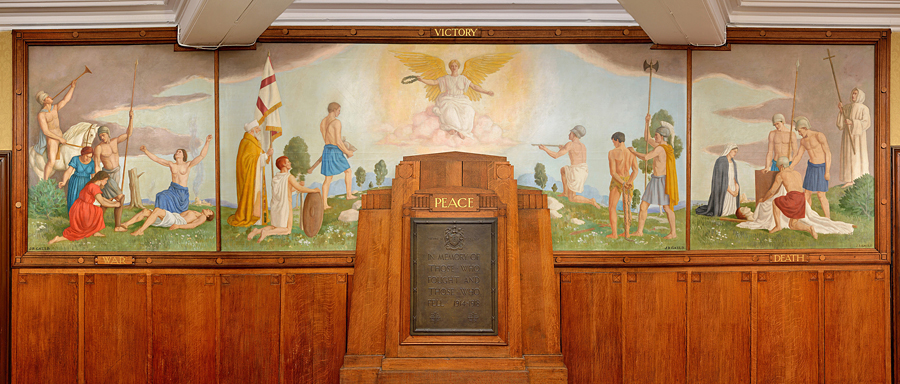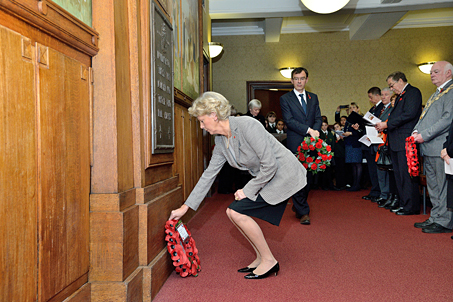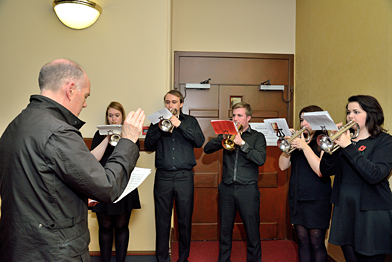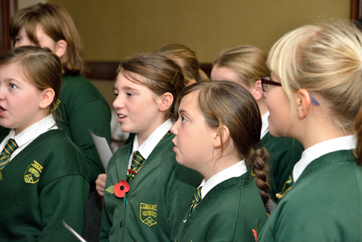University rededicates its World War One memorial

Thu, 13 Nov 2014 15:57:00 GMT
Wreaths were laid by the Lord-Lieutenant of West Yorkshire, Dr Ingrid Roscoe, and the Mayor of Kirklees, Councillor Ken Smith
 The Lord-Lieutenant of West Yorkshire, Dr Ingrid Roscoe (right), lays a wreath at the University's World War One Memorial
The Lord-Lieutenant of West Yorkshire, Dr Ingrid Roscoe (right), lays a wreath at the University's World War One Memorial
AS the centenary year of the outbreak of World War One draws to its close, the University of Huddersfield has paid its tribute to staff and students of the institution who died in The Great War. A special ceremony was held to rededicate a remarkable memorial painting that was first unveiled in the grief-stricken aftermath of the conflict.
The painting is a three-part allegory depicting War, Death and Victory and it incorporates an oaken cenotaph that represents Peace. The artwork occupies a first floor landing wall in the Ramsden Building, now the historic heart of the University. In the early 1900s, it was the home of Huddersfield Technical College, which saw thousands of its staff, students and former students go to war. Hundreds never returned, and among the dead were four members of the college’s full-time staff.
The memorial was officially unveiled in September 1924. It was painted by John Richardson Gauld, who came to the college as a substitute for the art teacher Willie Speight, of Batley, who had volunteered for the army in the early stages of the conflict. He died July 1916, during the Battle of the Somme.
 Rededication Service
Rededication Service
The service to rededicate the memorial was led by the Rev Anita Raggett, who is the University’s Anglican Chaplain. Wreaths were laid by the Lord-Lieutenant of West Yorkshire, Dr Ingrid Roscoe, the Mayor of Kirklees, Councillor Ken Smith, and by the University’s Pro Vice-Chancellor, Professor Tim Thornton, who begun the ceremony by outlining the history of the wall painting and describing its original dedication in 1924.
The mural depicted, War, Death and Victory, but for families of those who had fallen, that victory must have seemed a hollow one, said Professor Thornton.
The University of Huddersfield has published a 528-page guide to the lives and deaths of thousands of WWI servicemen from the district. Titled Huddersfield’s Roll of Honour 1914-1922, it was compiled by local historian Margaret Stansfield – who died before publication – and was edited by the Rev Paul Wilcock, who heads the University’s Arms and Armour Research Institute.
 At the rededication ceremony, Mr Wilcock read two representative entries from the book. One of them dealt with Lance Corporal Harry Topping, who was assistant secretary of Huddersfield Technical College. The son of a Huddersfield councillor, he joined the Royal Welsh Fusiliers and survived a serious gas attack before being killed in battle in March, 1918.
At the rededication ceremony, Mr Wilcock read two representative entries from the book. One of them dealt with Lance Corporal Harry Topping, who was assistant secretary of Huddersfield Technical College. The son of a Huddersfield councillor, he joined the Royal Welsh Fusiliers and survived a serious gas attack before being killed in battle in March, 1918.
The other entry read by Mr Wilcock described Private James O’Brien. Huddersfield born, he was a promising artist who studied at the Technical College. Having joined the West Yorkshire Regiment, he was killed in action in 1916.
A group of cornet students from the University’s music department performed the Last Post and the Reveille, conducted by Phillip McCann, who is Head of Brass and Woodwind. And there was an echo of the 1924 ceremony when 13 members of the Lindley Junior School Choir, conducted by Alison North, performed the hymn “O God, our help in ages past”, which was sung at the original dedication.
Prayers were led by the Rev Anita Raggett and by Deacon Gill Atkinson-Heck, who is the University’s Free Church Chaplain.







